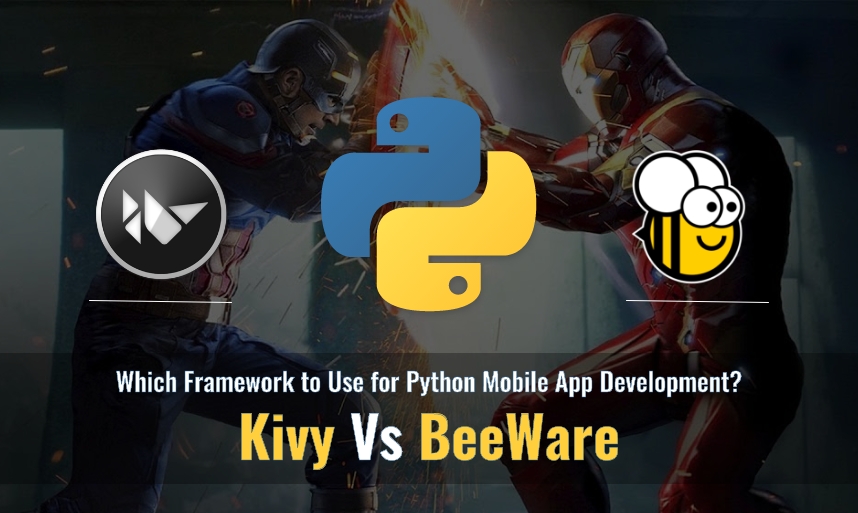A few years back, creating mobile applications using Python was almost a pipedream. But today, even Python has entered into the race that follows the phrase, “Write once, deploy everywhere”. Surprised right? Well, yes, using a few suites of tools it is possible to build mobile applications using Python. Things have shuffled and Python is now capable of delivering Android and iOS platforms. Thanks to the two major python app development frameworks, Kivy, and BeeWare. In this article, we have run a small comparison between Kivy Vs BeeWare that will help you in having a better understanding of both.
We can say it was the need of the hour for the Python community to come up with the solution that allows direct deployment of apps on iOS and Android. Millions of Python lovers awaited the release of the frameworks that would allow them to write mobile applications using Python. The two frameworks, Kivy and BeeWare added on to the Python’s strength of app development. This allowed developers to take advantage of Python for mobile applications.
These framework libraries play a major role and you can easily build applications using Python’s clear syntax. Let’s have a look at them.
Let’s understand the Kivy framework:
Kivy is an open-source Python library that can be used to deploy mobile applications across multiple platforms. The framework was released in the year 2011 and extends its support to multitouch events, regular keyboard inputs as well as mouse inputs. Kivy has the potential to act and strengthen with the platform they are deployed on.
It is used to create graphical user interfaces that can run seamlessly on Android and iOS. However, the common expectation from an application is, it should give the feel almost the same as native.
However, Kivy is a cross-platform tool kit having its own version of buttons, text labels, fonts and more. This means it will deliver the consistency and portability of the developed application on various platforms. But, an Android app won’t actually feel like native Android.
Kivy doesn’t use native widgets or other controls. All of them are to be custom-drawn. This can be a plus point as well as a fallback depending on the type of application that you are planning to build.
Why? Because, if you are developing a game application for smartphones, the native features are not of much importance. Unless you wish to incorporate graphical MIDI controls for music then the native features of the platform have a huge impact.
Hence we can say, Kivy is the go-to choice of Python developers who wish to develop a non-native UI app. This is a plus point, that you can code and build a mobile application with the Kivy for iOS without even learning Swift programming language.
BeeWare framework:
BeeWare is again an open-source, reliable Python framework that facilitates a developer with the set of tools using which a developer can code an application that runs on iOS, Android, Linux, Windows or any other operating system.
The major difference between Kivy and BeeWare frameworks is that Kivy has its custom UI toolkit whereas BeeWare uses the platform’s native UI toolkit. Hence, you can pass on the same control across all the platforms using Kivy but can make your UI control appear the same, and have a native-like feel using BeeWare.
The buttons, checkboxes, and other elements are provided by the operating system if you use BeeWare for building an application.
You can have a native appearance, native behavior, in a native looking app using BeeWare. The only drawback of BeeWare is, it is still new in the market. Hence the potential of the framework is yet to be discovered in the coming years and Pythonista Russel Keith-Magee is leading this development.
We hope you are now clear about the basics of the framework. However, if you still have doubts, about Kivy vs BeeWare for Python app development, then we are elaborating on the discussion further. Let’s look at the pros and cons of both the framework:
Pros of Kivy:
It is an open-source Python library that is designed for fast application development;
Kivy functions seamlessly on Linux, Windows, Android, Raspberry Pi;
It allows you to run the same code base across all the platforms;
Just like Python is famous for clear syntax, Kivy also offers a better representation of all the functionalities in the program;
The programming style is more organized and precise when compared to other frameworks.
Cons of Kivy:
The developer has to compile the code at every step;
The framework alone is not suitable for building complex applications.
Pros of BeeWare:
It is also an open-source framework and the most reliable way to build robust software;
It gives native applications like the feel and looks to the app.
The BeeWare set of tools are BSD licensed and anyone can access/modify it;
It is backed by a huge community of developers who help in documentation, design, and bug solving;
The community is committed to develop and maintain the framework and rigorously work towards contributing to it.
Cons of BeeWare:
The possibilities of the framework are yet to be explored.
Final words:
Which is better? Kivy Vs BeeWare is a difficult question to be answered even by a python development company? The choice of selection depends completely on your project goals and specifications.
Both the frameworks are really interesting GUI frameworks, but the real competition lies in the look and feel of the final product. Kivy is a matured framework, whereas BeeWare is still in the development phase.
If this sounds interesting, you can connect with us for discussing your projects using Python. We would be more than happy if we can contribute to your journey of app development. We hope you enjoy your “Hello World” mobile app using Python.
